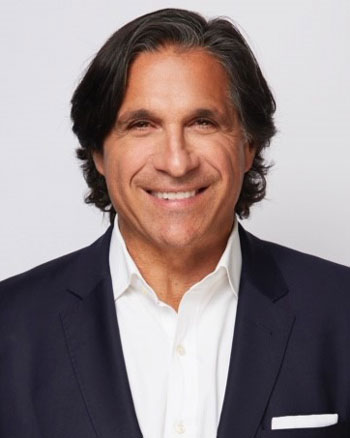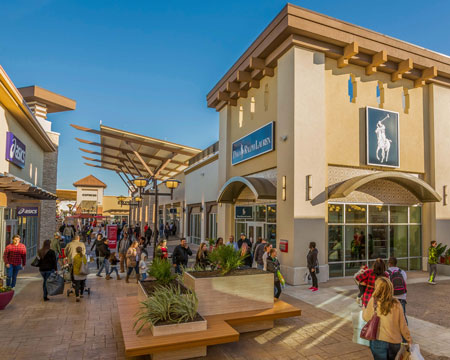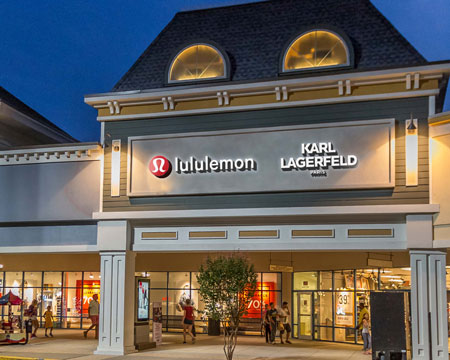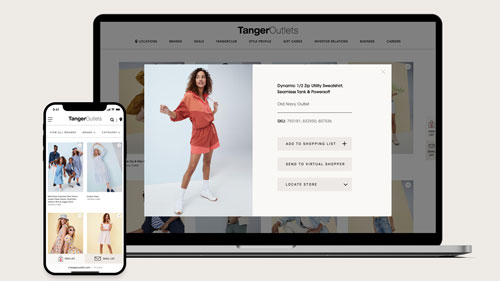Tanger CEO Stephen Yalof sees a heightened focus on customer experience as key.
With an entire career spent in retail, Stephen Yalof, president and CEO of Tanger Factory Outlet Centers, Inc. (NYSE: SKT), retains his lifelong passion for the industry and continues to look for new ways to enhance the customer experience. It is a strategy he believes is vital for the REIT’s continued success in the years ahead.
Yalof became president and COO of Tanger, a leading operator of open-air outlets across 20 states, in April 2020 before succeeding Steven Tanger as CEO in January 2021. Before joining Tanger, Yalof served as CEO of Simon Premium Outlets, part of Simon Property Group, Inc. (NYSE: SPG). Earlier positions include leadership roles at Ralph Lauren Corp. and The Gap, Inc.
Yalof joined Tanger just as shoppers at the REIT’s centers were forced to stay home in the early days of the pandemic. During that uncertain time, Yalof reflected on how to do things differently and make products available to Tanger shoppers. The answer he came up with was to focus on digital initiatives, improve food offerings and experiences, and add more local businesses—ideas that have lured back both tenants and shoppers who are now spending more time at Tanger’s 36 centers.
REIT magazine spoke with Yalof about corporate values, frictional vacancy and the benefits it can bring, and how the need for exercise pants turned into a virtual shopping experience.
In what way did the pandemic change how you operated the business?
We never laid off anybody during COVID. We truncated our hours, but we kept our staff. In fact, once stores began to reopen we actually used our staff to go out and shop.
It started with me. My son went back to college and took my Adidas sweatpants. I wanted to go for a run but couldn’t find my track pants, so I called the general manager of our shopping center in South Carolina and asked her to do me a favor and send me three pairs of pants. She replied, ‘I’ll do you one better,’ grabbed her phone, pushed FaceTime, and I literally shopped the store with her. That’s how it started. That became our virtual shopping model.
When I was at The Gap, I worked for (former executive) Mickey Drexler. He used to say: Whenever someone calls you up with a good idea, multiply that by the 50,000 people who have the same idea but aren’t going to give you a call. I figured that if I could use that service, why couldn’t our legion of VIPs and Insiders (the company’s loyalty shopping programs) do so as well. It turned out to be a pretty interesting way of getting in front of our customer, providing them a service they didn’t have. Some of the transactions ended with us just getting to know our customers a little bit better, but a lot of our transactions ended with a sale.
We thought that was an interesting program for us to take to the next step. What we learned is that our customers like to have that window shopping experience online but like to execute in store. By setting up our website as a place for people to see products and offering them the opportunity to order online and pick up curbside, or hold the purchase in the store, we are able to ensure they aren’t disappointed if something isn’t available at their local center.
We also gave them a third way of shopping, which is that virtual shopper program. In fact, we just brought in a new chief commercial officer to help us think about digital initiatives, and we’re going to grow that business.
How have outlet mall designs changed over the years and what will customers see next?
We learned a lot during COVID. We learned that people like to buy online and pick up curbside, so curbside pickup has become something that, fortunately for us being open-air, is a little bit easier to establish. As we build new shopping centers, and we’ve got one on the books that we will open up in 2023, we’ll have special curbside drive lanes. It’s also something that we’re thinking about incorporating into our existing centers in the future.
One of our goals is to get an outlet customer to stay longer when they come and to shop more frequently. A lot of that has to do with the digital communication and the amenities that we’re adding, whether it’s a Christmas tree lighting event or the holiday décor coupled with better food options to encourage customers to stay longer and ultimately buy more.
Where do you see the company in the next five years, 10 years?
We spent a lot of time last year thinking about our mission, our vision, and our values. In our vision statement, we say that we want to go from being a real estate company to a customer-experience company.
I think one of the big pivots for us is to consider how you become a customer experience company. I think it starts with those digital initiatives that we talked about. As the brands evolve and become more omnichannel, I think the retail space and certainly the retail space service providers need to think through how the customer wants to shop and meet that customer where they are.
What we’re finding is the customer that we’re cultivating right now cares a lot about sustainability, not only in the brands that they choose to shop, but in the shopping centers that they choose to shop in, so we’re engaging not only in e-charging stations for electric vehicles but we’re also doing a lot more solar initiatives.
Last year we did an initiative with a company that puts honeybees on the roof of a building. It was a great customer draw and we took schools and classrooms up and they met with our beekeepers. Our Chairman Steve Tanger and I, along with our senior leadership team, have made a commitment to reduce our carbon footprint and be more environmentally conscious going forward. A lot of those amenities and that thoughtfulness will be part of not only the shopping centers of the future but also the pivot for what existing shopping centers will ultimately look like.
Outlet centers are known for big retail players. What role do small businesses play?
There’s always going to be some empty space in the shopping center, it’s frictional vacancy. For example, we made a deal in Rehoboth Beach, Delaware, with Ulta Beauty, Inc. We had to move some people around in order to create space, so we will have some temporary vacancy.
In a case like this we’ll go out into the local communities and source a tenant to live in that space for that period of time. It gives them the opportunity to test the water before they decide to go full throttle into the retail business, so we get to see a lot of those brands holding their first retail pop-up.
We lost a lot of tenants during COVID due to brands restructuring or closing their stores. We found ourselves with more store vacancies than we’d had in a long time. Our general managers went to work and started knocking on doors in local marketplaces to try and get tenants to move in and occupy a lot of that space. In doing so we may have uncovered some of the brands of the future, whether it’s a Byrd’s Cookie Company in a market like Savannah, Georgia, or My Cookie Dealer shop in Riverhead, New York that opened up in our center and has lines out the door.
Last year, we set up a minority business initiative. When we found minority-owned businesses that might not have had the seed capital to open up the store, we worked with them on the rent. We gave them some buildout dollars to help them set up. We gave them the opportunity to open and get started and we then had a great tenant that had their own local following and was able to bring a new customer into our shopping centers.
We pride ourselves on being a field-led team, a local company. One of our core values is that we want to be participants in the communities that we serve. If you look at a lot of our shopping centers in these smaller communities, we’re the first job for a lot of people in those marketplaces. We’re the biggest gathering place and we’re probably, in a lot of these markets, one of the biggest revenue generators and the biggest taxpayers. If you have 100 stores, that’s a lot of jobs for a lot of people. That’s an important part of the community.
How has Tanger addressed stakeholder demands for more action in ESG?
We’re really the stakeholder and the ones that are demanding action. We’re a people-first, locally driven company that cares about the communities it serves. You can talk about it all day long, but you really have to walk the walk.
We express that in how we choose the national holidays that our team celebrates. We’re one of very few companies that gives 40 hours of paid time off to our employees to volunteer because we think that’s a really important part of our business. If we’re going to be a field-led, community-driven company, we need to get out and serve the community.
During COVID, or when there’s been a disaster in one of our communities, we’ve become a place where people gather for a blood drive, food distribution, Red Cross distribution, clothing drives, etc. We use our parking fields and our common area as a place for people to set up their relief stations. For Voter Registration Day, we partnered with HeadCount and set up voter registration at more than half of our shopping centers.
It starts from the example that the leadership sets, but also I think it’s important that leadership listens to the people in our organization.
How are you putting your stamp on your position?
I have 30 years-plus of outlet shopping center experience. I started my career leasing outlet centers in the early 1990s when outlet centers were a lot different than what we see today.
I think I’ve had great experience working for both the landlord side and retailer side. I understand the retailer’s perspective almost as well as I understand the landlord’s perspective, and in some instances maybe better because I’ve negotiated deals from both sides.
I also think this business is a relationship business. The people I can pick up the phone to call are folks that I’ve been friends with and have had relationships with and have done business with for a long period of time. That eases a lot of the difficulty in getting things done.
It’s fun when younger people ask me what’s the first thing to know about being in the shopping center business. I can teach them how to do the math, how to merchandise, build a leasing plan, how to pick up the phone and call people, but I can’t teach how to really care about the people you do business with.
I always find that the people who are the most successful are the ones who care about the people they do business with. People want to do business with the people they like and trust who also treat you fairly. You’re not going to necessarily win on every deal that you do, but if you have a really good reputation in the business, people are going to want to do business with you.
Tanger has established that for a long period of time. They’ve always been a great company to do business with as they’ve changed and modernized. As the years have gone by, they’ve understood what’s important to the customer and gone after it. I’m continuing to carry that legacy.



